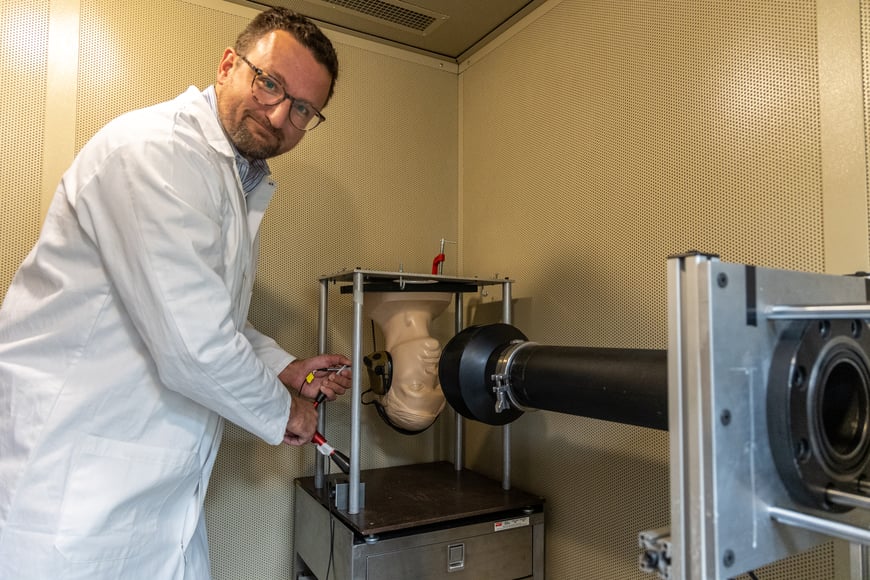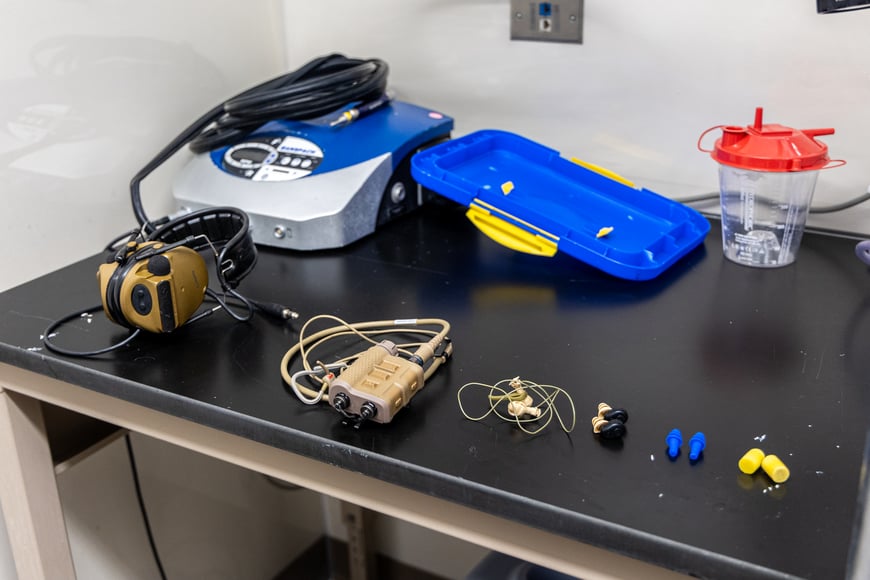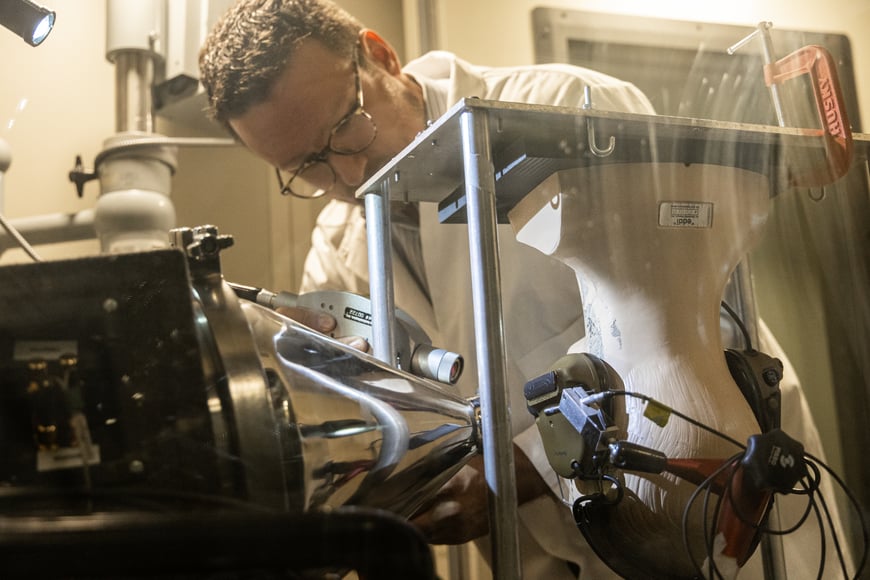Hearing loss prevalence increases with age, and nearly 90% of Americans over the age of 80 have lost some or most of their hearing, a toll taken by a lifetime of noise that goes beyond the sense of sound. Research links hearing deficits with social isolation, cognition issues and dementia, underscoring the need for hearing protection.
“Hearing loss is the single largest modifiable risk factor for dementia or increases in rates of dementia,” said Nathaniel Greene, PhD, assistant professor of otolaryngology at the University of Colorado School of Medicine. Greene and his research team are working to advance the science behind hearing loss and protection in hopes of having a greater impact.
“I think it’s an interesting problem to solve. Part of it is there is a knowledge gap that currently we don’t know how to predict these injuries. If we can better predict a hearing loss injury, we can provide better predictions for how much injury an individual might receive for a different exposure. Then we can better advise the decision-makers on how to protect exposed individuals.”
Sound and the limits of the human ear
This complex problem starts with understanding the human auditory system and its relationship with sound, and involves understanding the various types of noise exposure. For example, continuous, long-duration noises include a lawnmower or the steady thrum inside a factory, he said.
In contrast, loud and fast sounds – impulsive noises – arrive in burst fashion. “Think of a dumpster getting dropped next to you or shots on a firing range,” Greene said.
When researching noise and setting workplace environment policy, federal-prescribed protections are based on some caveats with regards to both continuous and impulsive noise. When people are exposed to impulsive noise above the 140-decibel threshold, for example, hearing protection is required.
But hearing protection and decibel limits are not a simple relationship.
“There are a lot of different types of impulse noise: a gun on a firing range, fireworks, aircraft flyovers,” Greene said. “The injuries you might get across noise sources will cause different types of injury and hearing loss. That part is not taken into account in these recommendations (hearing protections kick in at various exposure durations of lower decibel levels as well). It's just a strict 140 decibels.”
Building a lab to bring the noise
As an example of the complexity, Greene noted a study on hearing loss in the wake of the Boston Marathon bombing tragedy that compared two people standing right next to each other.
“One would have significant hearing loss and the other’s hearing would be totally fine. So, the 140-decibel limit is setting a conservative figure to protect people. But that's also the field saying: We don't have a better way of predicting this at this point.”

Greene with the shock tube capable of producing noise at 190 decibels. |
Injuries come down to a variety of factors, including noise level, source, distance and what direction a person is facing. All factors contribute to the difficulty in predicting hearing injuries.
|
Noise exposure duration and regulation According to Greene, the National Institute for Occupational Safety & Health (NIOSH) and Occupational Safety and Health Administration (OSHA) recommendations roughly state that if individuals exceed acceptable noise limits for a given time-frame, they need to wear hearing protection. “Basically, as you go up in level, the amount of acceptable time goes down,” Greene said. “If the exposure is 85 decibels for eight hours, you need hearing protection. Noise is on a logarithmic scale, so a step up of 3 to 5 decibels cuts the time allotment in half.” |
In both laboratory and public settings, impulse noises contrast readily with continuous noise, Greene said. “In continuous noise, we’re dealing with sound that is more easily tested and reproduced. It’s hard to produce incredibly loud impulsive noises in a laboratory setting and do it in a consistent, repeatable way.”
The researchers created setups to test the impacts of impulse noises on acoustic mannequins and donated cadaver specimens. They used a loudspeaker to gauge the response of ear changes with increasing levels of regular long-duration noise. The experiments then shifted to a shock tube – a device that generates noises from 170 to 190 decibels. The tube produces a shockwave similar in sound signature to a gunshot, explosion or supersonic aircraft.
Through miniature pressure sensors placed into the specimen’s inner ear, Greene’s team can monitor the shockwaves’ impact on human anatomy. “The inner-ear bones are very efficient at transmitting sound at lower levels,” Greene said. “But when you start to get some very high-level sounds like what we’re testing, the ligaments, tendons and muscles that hold them in place start to act a lot like an over-stretched rubber band, and their overall motion is limited.”
This rubber-band effect has an impact on the hair cells inside the ear. Because the middle ear motion is clipped, the sound arriving in the inner ear gets spread out, and everything gets stimulated. “You'll cause injury across the whole range of the cochlea – more of the hair cells will be stimulated and may become damaged,” Greene said.
|
Greene testing over-the-ear hearing protection in the lab. |
A path to better hearing protection and long-term health
Given the high risk of damage to hearing from impulsive noise, Greene’s team is also studying the effectiveness of current protection options, testing a variety of hearing protection devices in the shock tube. “We wanted to test how much we are over or underestimating the protection that different styles of hearing protectors provide.”
The team tested earmuffs, standard foam ear plugs, gel ear plugs and ear plugs with silicone flanges. Across all four styles, the findings showed an overestimation of damage protection against higher frequencies of impulsive sound. “Almost always, people lose their high-frequency hearing first,” Greene said. “We may be making this situation worse because we're not protecting those high frequencies as much as we think we are.”

Greene and the research team test a variety of hearing protection devices. |
The researchers hope new techniques to improve measurement sensitivity will have ripple effects to eventual hearing protection products. They are studying the directionality of sound and measuring other types of noise exposure, such as the amount a patient is exposed to during surgery.
“What we're trying to do is provide tools for those companies to better qualify their devices so that we can advise the users on what hearing protection is appropriate when.”
Greene also wants people to remember that lifelong hearing protection is important, because it all adds up.
“We can’t recover hearing once it’s lost,” he said. “Hearing loss is partly due to age, partly due to genetics, but a very large part of it is just an accumulation of noise exposures over your lifetime. If you can reduce that toll early on or continuously, then you can reduce the overall loss that you have later in life alongside related health effects.”





